Junjie Liu
Frustratingly Easy Task-aware Pruning for Large Language Models
Oct 26, 2025Abstract:Pruning provides a practical solution to reduce the resources required to run large language models (LLMs) to benefit from their effective capabilities as well as control their cost for training and inference. Research on LLM pruning often ranks the importance of LLM parameters using their magnitudes and calibration-data activations and removes (or masks) the less important ones, accordingly reducing LLMs' size. However, these approaches primarily focus on preserving the LLM's ability to generate fluent sentences, while neglecting performance on specific domains and tasks. In this paper, we propose a simple yet effective pruning approach for LLMs that preserves task-specific capabilities while shrinking their parameter space. We first analyze how conventional pruning minimizes loss perturbation under general-domain calibration and extend this formulation by incorporating task-specific feature distributions into the importance computation of existing pruning algorithms. Thus, our framework computes separate importance scores using both general and task-specific calibration data, partitions parameters into shared and exclusive groups based on activation-norm differences, and then fuses their scores to guide the pruning process. This design enables our method to integrate seamlessly with various foundation pruning techniques and preserve the LLM's specialized abilities under compression. Experiments on widely used benchmarks demonstrate that our approach is effective and consistently outperforms the baselines with identical pruning ratios and different settings.
Efficient Reasoning Through Suppression of Self-Affirmation Reflections in Large Reasoning Models
Jun 14, 2025
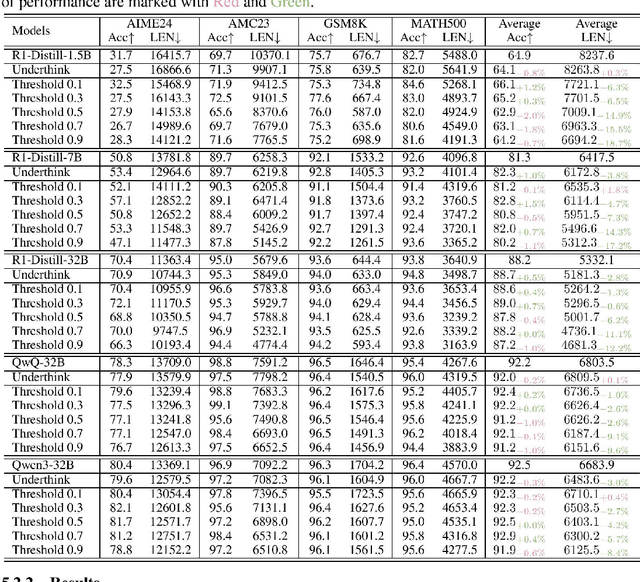
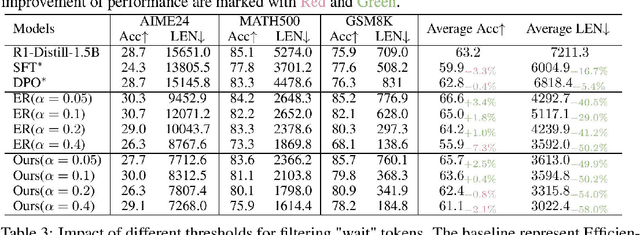
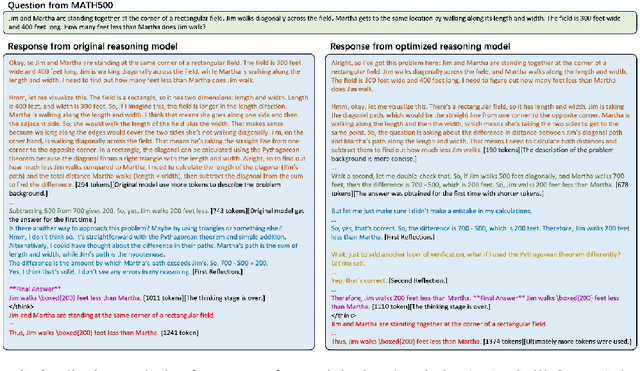
Abstract:While recent advances in large reasoning models have demonstrated remarkable performance, efficient reasoning remains critical due to the rapid growth of output length. Existing optimization approaches highlights a tendency toward "overthinking", yet lack fine-grained analysis. In this work, we focus on Self-Affirmation Reflections: redundant reflective steps that affirm prior content and often occurs after the already correct reasoning steps. Observations of both original and optimized reasoning models reveal pervasive self-affirmation reflections. Notably, these reflections sometimes lead to longer outputs in optimized models than their original counterparts. Through detailed analysis, we uncover an intriguing pattern: compared to other reflections, the leading words (i.e., the first word of sentences) in self-affirmation reflections exhibit a distinct probability bias. Motivated by this insight, we can locate self-affirmation reflections and conduct a train-free experiment demonstrating that suppressing self-affirmation reflections reduces output length without degrading accuracy across multiple models (R1-Distill-Models, QwQ-32B, and Qwen3-32B). Furthermore, we also improve current train-based method by explicitly suppressing such reflections. In our experiments, we achieve length compression of 18.7\% in train-free settings and 50.2\% in train-based settings for R1-Distill-Qwen-1.5B. Moreover, our improvements are simple yet practical and can be directly applied to existing inference frameworks, such as vLLM. We believe that our findings will provide community insights for achieving more precise length compression and step-level efficient reasoning.
GeoCAD: Local Geometry-Controllable CAD Generation
Jun 12, 2025Abstract:Local geometry-controllable computer-aided design (CAD) generation aims to modify local parts of CAD models automatically, enhancing design efficiency. It also ensures that the shapes of newly generated local parts follow user-specific geometric instructions (e.g., an isosceles right triangle or a rectangle with one corner cut off). However, existing methods encounter challenges in achieving this goal. Specifically, they either lack the ability to follow textual instructions or are unable to focus on the local parts. To address this limitation, we introduce GeoCAD, a user-friendly and local geometry-controllable CAD generation method. Specifically, we first propose a complementary captioning strategy to generate geometric instructions for local parts. This strategy involves vertex-based and VLLM-based captioning for systematically annotating simple and complex parts, respectively. In this way, we caption $\sim$221k different local parts in total. In the training stage, given a CAD model, we randomly mask a local part. Then, using its geometric instruction and the remaining parts as input, we prompt large language models (LLMs) to predict the masked part. During inference, users can specify any local part for modification while adhering to a variety of predefined geometric instructions. Extensive experiments demonstrate the effectiveness of GeoCAD in generation quality, validity and text-to-CAD consistency. Code will be available at https://github.com/Zhanwei-Z/GeoCAD.
Bipedal Robust Walking on Uneven Footholds: Piecewise Slope LIPM with Discrete Model Predictive Control
Apr 03, 2025Abstract:This study presents an enhanced theoretical formulation for bipedal hierarchical control frameworks under uneven terrain conditions. Specifically, owing to the inherent limitations of the Linear Inverted Pendulum Model (LIPM) in handling terrain elevation variations, we develop a Piecewise Slope LIPM (PS-LIPM). This innovative model enables dynamic adjustment of the Center of Mass (CoM) height to align with topographical undulations during single-step cycles. Another contribution is proposed a generalized Angular Momentum-based LIPM (G-ALIP) for CoM velocity compensation using Centroidal Angular Momentum (CAM) regulation. Building upon these advancements, we derive the DCM step-to-step dynamics for Model Predictive Control MPC formulation, enabling simultaneous optimization of step position and step duration. A hierarchical control framework integrating MPC with a Whole-Body Controller (WBC) is implemented for bipedal locomotion across uneven stepping stones. The results validate the efficacy of the proposed hierarchical control framework and the theoretical formulation.
Don't Take Things Out of Context: Attention Intervention for Enhancing Chain-of-Thought Reasoning in Large Language Models
Mar 14, 2025Abstract:Few-shot Chain-of-Thought (CoT) significantly enhances the reasoning capabilities of large language models (LLMs), functioning as a whole to guide these models in generating reasoning steps toward final answers. However, we observe that isolated segments, words, or tokens within CoT demonstrations can unexpectedly disrupt the generation process of LLMs. The model may overly concentrate on certain local information present in the demonstration, introducing irrelevant noise into the reasoning process and potentially leading to incorrect answers. In this paper, we investigate the underlying mechanism of CoT through dynamically tracing and manipulating the inner workings of LLMs at each output step, which demonstrates that tokens exhibiting specific attention characteristics are more likely to induce the model to take things out of context; these tokens directly attend to the hidden states tied with prediction, without substantial integration of non-local information. Building upon these insights, we propose a Few-shot Attention Intervention method (FAI) that dynamically analyzes the attention patterns of demonstrations to accurately identify these tokens and subsequently make targeted adjustments to the attention weights to effectively suppress their distracting effect on LLMs. Comprehensive experiments across multiple benchmarks demonstrate consistent improvements over baseline methods, with a remarkable 5.91% improvement on the AQuA dataset, further highlighting the effectiveness of FAI.
Knowledge Distillation with Adapted Weight
Jan 06, 2025Abstract:Although large models have shown a strong capacity to solve large-scale problems in many areas including natural language and computer vision, their voluminous parameters are hard to deploy in a real-time system due to computational and energy constraints. Addressing this, knowledge distillation through Teacher-Student architecture offers a sustainable pathway to compress the knowledge of large models into more manageable sizes without significantly compromising performance. To enhance the robustness and interpretability of this framework, it is critical to understand how individual training data impact model performance, which is an area that remains underexplored. We propose the \textbf{Knowledge Distillation with Adaptive Influence Weight (KD-AIF)} framework which leverages influence functions from robust statistics to assign weights to training data, grounded in the four key SAFE principles: Sustainability, Accuracy, Fairness, and Explainability. This novel approach not only optimizes distillation but also increases transparency by revealing the significance of different data. The exploration of various update mechanisms within the KD-AIF framework further elucidates its potential to significantly improve learning efficiency and generalization in student models, marking a step toward more explainable and deployable Large Models. KD-AIF is effective in knowledge distillation while also showing exceptional performance in semi-supervised learning with outperforms existing baselines and methods in multiple benchmarks (CIFAR-100, CIFAR-10-4k, SVHN-1k, and GLUE).
NeutraSum: A Language Model can help a Balanced Media Diet by Neutralizing News Summaries
Jan 02, 2025



Abstract:Media bias in news articles arises from the political polarisation of media outlets, which can reinforce societal stereotypes and beliefs. Reporting on the same event often varies significantly between outlets, reflecting their political leanings through polarised language and focus. Although previous studies have attempted to generate bias-free summaries from multiperspective news articles, they have not effectively addressed the challenge of mitigating inherent media bias. To address this gap, we propose \textbf{NeutraSum}, a novel framework that integrates two neutrality losses to adjust the semantic space of generated summaries, thus minimising media bias. These losses, designed to balance the semantic distances across polarised inputs and ensure alignment with expert-written summaries, guide the generation of neutral and factually rich summaries. To evaluate media bias, we employ the political compass test, which maps political leanings based on economic and social dimensions. Experimental results on the Allsides dataset demonstrate that NeutraSum not only improves summarisation performance but also achieves significant reductions in media bias, offering a promising approach for neutral news summarisation.
Seeking the Sufficiency and Necessity Causal Features in Multimodal Representation Learning
Aug 29, 2024Abstract:Learning representations with a high Probability of Necessary and Sufficient Causes (PNS) has been shown to enhance deep learning models' ability. This task involves identifying causal features that are both sufficient (guaranteeing the outcome) and necessary (without which the outcome cannot occur). However, current research predominantly focuses on unimodal data, and extending PNS learning to multimodal settings presents significant challenges. The challenges arise as the conditions for PNS identifiability, Exogeneity and Monotonicity, need to be reconsidered in a multimodal context, where sufficient and necessary causal features are distributed across different modalities. To address this, we first propose conceptualizing multimodal representations as comprising modality-invariant and modality-specific components. We then analyze PNS identifiability for each component, while ensuring non-trivial PNS estimation. Finally, we formulate tractable optimization objectives that enable multimodal models to learn high-PNS representations, thereby enhancing their predictive performance. Experiments demonstrate the effectiveness of our method on both synthetic and real-world data.
Face Clustering via Early Stopping and Edge Recall
Aug 24, 2024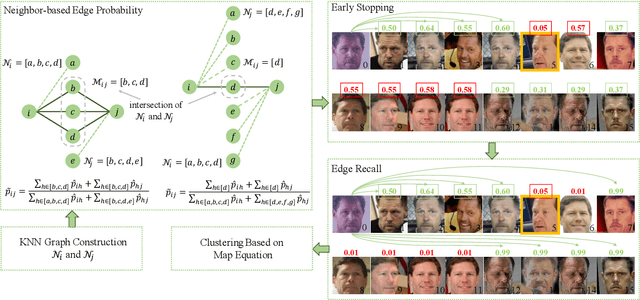
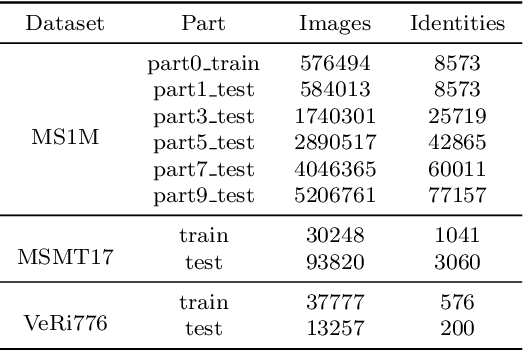
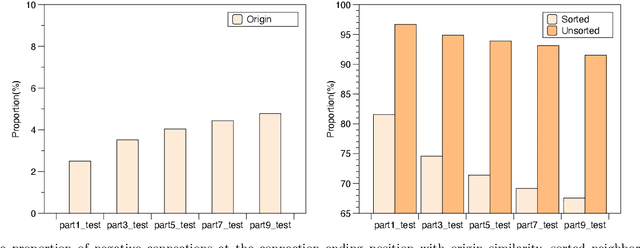
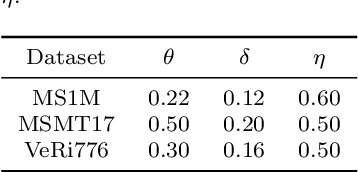
Abstract:Large-scale face clustering has achieved significant progress, with many efforts dedicated to learning to cluster large-scale faces with supervised-learning. However, complex model design and tedious clustering processes are typical in existing methods. Such limitations result in infeasible clustering in real-world applications. Reasonable and efficient model design and training need to be taken into account. Besides, developing unsupervised face clustering algorithms is crucial, which are more realistic in real-world applications. In this paper, we propose a novel unsupervised face clustering algorithm FC-ES and a novel supervised face clustering algorithm FC-ESER to address these issues. An efficient and effective neighbor-based edge probability and a novel early stopping strategy are proposed in FC-ES, guaranteeing the accuracy and recall of large-scale face clustering simultaneously. Furthermore, to take advantage of supervised learning, a novel edge recall strategy is proposed in FC-ESER to further recall the edge connections that are not connected in FC-ES. Extensive experiments on multiple benchmarks for face, person, and vehicle clustering show that our proposed FC-ES and FC-ESER significantly outperform previous state-of-the-art methods. Our code will be available at https://github.com/jumptoliujj/FC-ESER.
Multiple Prior Representation Learning for Self-Supervised Monocular Depth Estimation via Hybrid Transformer
Jun 13, 2024



Abstract:Self-supervised monocular depth estimation aims to infer depth information without relying on labeled data. However, the lack of labeled information poses a significant challenge to the model's representation, limiting its ability to capture the intricate details of the scene accurately. Prior information can potentially mitigate this issue, enhancing the model's understanding of scene structure and texture. Nevertheless, solely relying on a single type of prior information often falls short when dealing with complex scenes, necessitating improvements in generalization performance. To address these challenges, we introduce a novel self-supervised monocular depth estimation model that leverages multiple priors to bolster representation capabilities across spatial, context, and semantic dimensions. Specifically, we employ a hybrid transformer and a lightweight pose network to obtain long-range spatial priors in the spatial dimension. Then, the context prior attention is designed to improve generalization, particularly in complex structures or untextured areas. In addition, semantic priors are introduced by leveraging semantic boundary loss, and semantic prior attention is supplemented, further refining the semantic features extracted by the decoder. Experiments on three diverse datasets demonstrate the effectiveness of the proposed model. It integrates multiple priors to comprehensively enhance the representation ability, improving the accuracy and reliability of depth estimation. Codes are available at: \url{https://github.com/MVME-HBUT/MPRLNet}
 Add to Chrome
Add to Chrome Add to Firefox
Add to Firefox Add to Edge
Add to Edge